TGV

TGV

 TGV Duplex leaving Nice | |
| Locale | France, with services extending to Belgium, Luxembourg, Germany, Switzerland, Italy, Spain and the Netherlands |
|---|---|
| Dates of operation | 1981–present |
| Track gauge | 1,435 mm(4 ft 81⁄2 in) (standard gauge) |
| Website | TGV on sncf.com [67] |
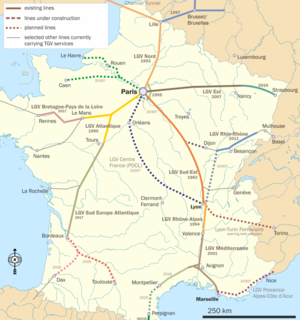 High-speed lines in France | |
The TGV (French: Train à Grande Vitesse, "high-speed train") is France's intercity high-speed rail service, operated by the SNCF, the state-owned national rail operator. The SNCF started working on a high-speed rail network in 1966 and later presented the project to President Valéry Giscard d'Estaing who approved it. Originally designed as turbotrains to be powered by gas turbines, TGV prototypes evolved into electric trains with the 1973 oil crisis. In 1976 the SNCF ordered 87 high-speed trains from GEC-Alsthom. Following the inaugural service between Paris and Lyon in 1981 on the LGV Sud-Est (LGV for Ligne à Grande Vitesse; "high-speed line"), the network, centered on Paris, has expanded to connect major cities across France (Marseille, Lille, Bordeaux, Strasbourg, Rennes, Montpellier) and in neighbouring countries on a combination of high-speed and conventional lines. The TGV network in France carries about 110 million passengers a year.
Like the Shinkansen in Japan, the TGV has never experienced a fatal accident during its operational history; the onboard security systems are among the world's most advanced. The high-speed tracks, maintained by SNCF Réseau, are also subject to heavy regulation. Confronted with the fact that train drivers would not be able to see signals along the track-side when trains reach full speed, engineers developed the TVM technology, which would later be exported worldwide. It allows for a train engaging in an emergency braking to request within seconds all following trains to reduce their speed; if a driver does not react within 1.5 km (0.93 mi), the system overrides the controls and reduces the train's speed automatically. The TVM safety mechanism enables TGVs using the same line to depart every three minutes.[3][4]
A TGV test train set the world record for the fastest wheeled train, reaching 574.8 km/h (357.2 mph) on 3 April 2007.[5] Conventional TGV services operate up to 320 km/h (200 mph) on the LGV Est, LGV Rhin-Rhône and LGV Méditerranée.[6] In 2007, the world's fastest scheduled rail journey was a start-to-stop average speed of 279.4 km/h (173.6 mph) between the Gare de Champagne-Ardenne and Gare de Lorraine on the LGV Est,[7][8] not surpassed until the 2013 reported average of 283.7 km/h (176.3 mph) express service on the Shijiazhuang to Zhengzhou segment of China's Shijiazhuang–Wuhan high-speed railway.[9]
The TGV was conceived at the same period as other technological projects sponsored by the Government of France, including the Ariane 1 rocket and Concorde supersonic airliner; those funding programmes were known as champion national policies (literal translation: national champion). The commercial success of the first high-speed line led to a rapid development of services to the south (LGV Rhône-Alpes, LGV Méditerranée, LGV Nîmes–Montpellier), west (LGV Atlantique, LGV Bretagne-Pays de la Loire, LGV Sud Europe Atlantique), north (LGV Nord, LGV Interconnexion Est) and east (LGV Rhin-Rhône, LGV Est). Eager to emulate the TGV's success, neighbouring countries Italy, Spain and Germany developed their own high-speed rail services.
The TGV system itself extends to neighbouring countries, either directly (Italy, Spain, Belgium, Luxembourg and Germany) or through TGV-derivative networks linking France to Switzerland (Lyria), to Belgium, Germany and the Netherlands (Thalys), as well as to the United Kingdom (Eurostar). Several future lines are planned, including extensions within France and to surrounding countries. Cities such as Tours and Le Mans have become part of a "TGV commuter belt" around Paris; the TGV also serves Charles de Gaulle Airport and Lyon–Saint-Exupéry Airport. A visitor attraction in itself, it stops at Disneyland Paris and in tourist cities such as Avignon and Aix-en-Provence as well. Brest, Chambéry, Nice, Toulouse and Biarritz are reachable by TGVs running on a mix of LGVs and modernised lines. In 2007, the SNCF generated profits of €1.1 billion (approximately US$1.75 billion, £875 million) driven largely by higher margins on the TGV network.[10][11]
 TGV Duplex leaving Nice | |
| Locale | France, with services extending to Belgium, Luxembourg, Germany, Switzerland, Italy, Spain and the Netherlands |
|---|---|
| Dates of operation | 1981–present |
| Track gauge | 1,435 mm(4 ft 81⁄2 in) (standard gauge) |
| Website | TGV on sncf.com [67] |
 High-speed lines in France | |
History
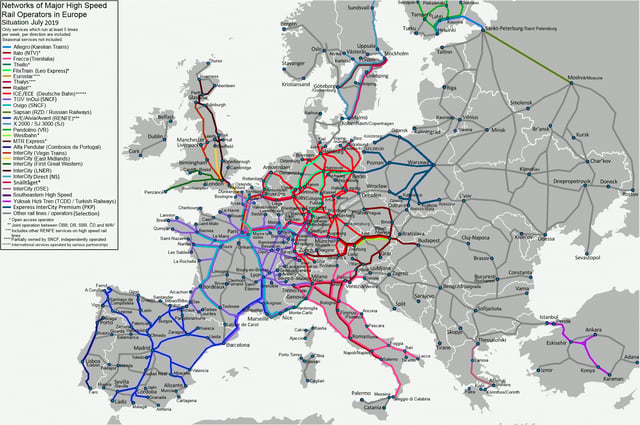
Europe's high-speed rail system, TGV Lines are Available in France
The idea of the TGV was first proposed in the 1960s, after Japan had begun construction of the Shinkansen (also known as the "bullet train") in 1959. At the time the Government of France favoured new technology, exploring the production of hovercraft and the Aérotrain air-cushion vehicle. Simultaneously, the SNCF began researching high-speed trains on conventional tracks. In 1976, the administration agreed to fund the first line. By the mid-1990s, the trains were so popular that SNCF President Louis Gallois declared that the TGV was "the train that saved French railways".[12]
Development
It was originally planned that the TGV, then standing for très grande vitesse ("very high speed") or turbine grande vitesse ("high-speed turbine"), would be propelled by gas turbines, selected for their small size, good power-to-weight ratio and ability to deliver high power over an extended period. The first prototype, TGV 001, was the only gas-turbine TGV: following the increase in the price of oil during the 1973 energy crisis, gas turbines were deemed uneconomic and the project turned to electricity from overhead lines, generated by new nuclear power stations.
TGV 001 was not a wasted prototype:[13] its gas turbine was only one of its many new technologies for high-speed rail travel. It also tested high-speed brakes, needed to dissipate the large amount of kinetic energy of a train at high speed, high-speed aerodynamics, and signalling. It was articulated, comprising two adjacent carriages sharing a bogie, allowing free yet controlled motion with respect to one another. It reached 318 km/h (198 mph), which remains the world speed record for a non-electric train. Its interior and exterior were styled by British-born designer Jack Cooper, whose work formed the basis of early TGV designs, including the distinctive nose shape of the first power cars.
Changing the TGV to electric traction required a significant design overhaul. The first electric prototype, nicknamed Zébulon, was completed in 1974, testing features such as innovative body mounting of motors, pantographs, suspension and braking. Body mounting of motors allowed over 3 tonnes to be eliminated from the power cars and greatly reduced the unsprung weight. The prototype travelled almost 1,000,000 km (620,000 mi) during testing.
In 1976 the French administration funded the TGV project, and construction of the LGV Sud-Est, the first high-speed line (French: ligne à grande vitesse), began shortly afterwards. The line was given the designation LN1, Ligne Nouvelle 1 ("New Line 1"). After two pre-production trainsets (nicknamed Patrick and Sophie) had been tested and substantially modified, the first production version was delivered on 25 April 1980.
Service
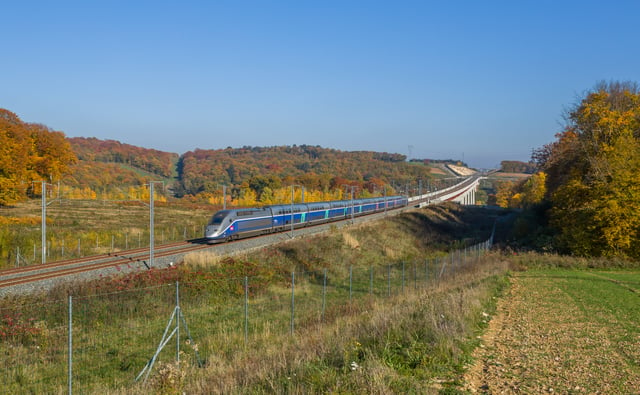
A TGV Duplex in Héricourt, Haute-Saône on the LGV Rhin-Rhône
The TGV opened to the public between Paris and Lyon on 27 September 1981. Contrary to its earlier fast services, SNCF intended TGV service for all types of passengers, with the same initial ticket price as trains on the parallel conventional line. To counteract the popular misconception that the TGV would be a premium service for business travellers, SNCF started a major publicity campaign focusing on the speed, frequency, reservation policy, normal price, and broad accessibility of the service.[14] This commitment to a democratised TGV service was enhanced in the Mitterrand era with the promotional slogan "Progress means nothing unless it is shared by all".[15] The TGV was considerably faster (in terms of door to door travel time) than normal trains, cars, or aeroplanes. The trains became widely popular, the public welcoming fast and practical travel.
The Eurostar service began operation in 1994, connecting continental Europe to London via the Channel Tunnel and the LGV Nord-Europe with a version of the TGV designed for use in the tunnel and the United Kingdom. The first phase of the British High Speed 1 line, or Channel Tunnel Rail Link, was completed in 2003, the second phase in November 2007. The fastest trains take 2 hours 15 minutes London–Paris and 1 hour 51 minutes London–Brussels. The first twice-daily London-Amsterdam service ran April 3, and took 3 hours 47 minutes.[16]
Milestones
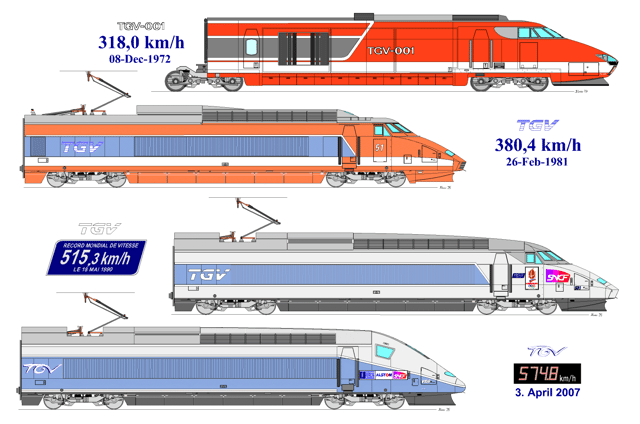
Record runs of the TGV
The TGV was the world's fourth commercial and third standard gauge high-speed train service,[17] after Japan's Shinkansen, which connected Tokyo and Osaka from 1 October 1964, the Russian ER200 around 1974 (full service in 1984), and Britain's InterCity 125 on main lines such as the East Coast Main Line, which entered service in 1976.
A modified TGV test train holds the world speed record for conventional trains. On 3 April 2007 a modified TGV POS train reached 574.8 km/h (357.2 mph) under test conditions on the LGV Est between Paris and Strasbourg. The line voltage was boosted to 31 kV, and extra ballast was tamped onto the permanent way. The train beat the 1990 world speed record of 515.3 km/h (320.2 mph), set by a similarly shortened train (two power cars and three passenger cars), along with unofficial records set during weeks preceding the official record run. The test was part of an extensive research programme by Alstom.[18][19]
In 2007 the TGV was the world's fastest conventional scheduled train: one journey's average start-to-stop speed from Champagne-Ardenne Station to Lorraine Station is 279.3 km/h (173.5 mph).[7][8] This record was surpassed on 26 December 2009 by the new Wuhan-Guangzhou High-Speed Railway[20] in China where the fastest scheduled train covered 922 km (573 mi) at an average speed of 312.54 km/h (194.20 mph). However, on 1 July 2011 in order to save energy and reduce operating costs the maximum speed of Chinese high-speed trains was reduced to 300 km/h, but services between Shijiazhuang and Zhengzhou East on the line still achieve 283.4 km/h (176.1 mph) in each direction in 2015.[21] The revival of 350 km/h operation in 2017 on the Beijing–Shanghai high-speed railway allows for several services to complete the 1,318 km (819 mi) journey between Shanghai and Beijing in 4 hours and 24 min with an average speed of 299.5 km/h (186.1 mph).[22]
A Eurostar (TGV) train broke the record for the longest non-stop high-speed international journey on 17 May 2006 carrying the cast and filmmakers of The Da Vinci Code from London to Cannes for the Cannes Film Festival. The 1,421-kilometre (883 mi) journey took 7 hours 25 minutes on an average speed of 191.6 km/h (119.1 mph).[23]
The fastest single long distance run on the TGV was done by a TGV Réseau train from Calais-Frethun to Marseille (1067.2 km, 663 mi) in 3 hours 29 minutes at a speed of 306 km/h (190 mph) for the inauguration of the LGV Méditerranée on 26 May 2001.[24]
Passenger usage
On 28 November 2003 the TGV network carried its one billionth passenger, a distant second only to the Shinkansen's five billionth passenger in 2000.
Excluding international traffic, the TGV system carried 98 million passengers during 2008, an increase of 8 million (9.1%) on the previous year.[25]
| Decade | Passengers (millions)[26] | |||||||||
|---|---|---|---|---|---|---|---|---|---|---|
| 1980s | 1980 | 1981 | 1982 | 1983 | 1984 | 1985 | 1986 | 1987 | 1988 | 1989 |
– | 1.26 | 6.08 | 9.20 | 13.77 | 15.38 | 15.57 | 16.97 | 18.10 | 19.16 | |
| 1990s [1][2] | 1990 | 1991 | 1992 | 1993 | 1994 | 1995 | 1996 | 1997 | 1998 | 1999 |
| 29.93 | 37.00 | 39.30 | 40.12 | 43.91 | 46.59 | 55.73 | 62.60 | 71.00 | 74.00 | |
| 2000s | 2000 | 2001 | 2002 | 2003 | 2004 | 2005 | 2006 | 2007 | 2008 | 2009 |
| 79.70 | 83.50 | 87.90 | 86.70 | 90.80 | 94.00 | 97.00 | 106.00 | 114.00 | 122.00 | |
| 2010s | 2010 | |||||||||
| 114.45 | ||||||||||
Rolling stock
TGVs have semi-permanently coupled articulated un-powered coaches, with Jacobs bogies between the coaches supporting both of them. Power cars at each end of the trains have their own bogies. Trains can be lengthened by coupling two TGVs, using couplers hidden in the noses of the power cars. The articulated design is advantageous during a derailment, as the passenger carriages are more likely to stay upright and in line with the track. Normal trains could split at couplings and jackknife, as seen in the Eschede train disaster. A disadvantage is that it is difficult to split sets of carriages. While power cars can be removed from trains by standard uncoupling procedures, specialised depot equipment is needed to split carriages, by lifting the entire train at once. Once uncoupled, one of the carriage ends is left without a bogie at the split, so a bogie frame is required to support it.
There are about 550 TGVs, of nine types:
SNCF TGV Sud-Est (8 carriages)
SNCF TGV Atlantique (10 carriages)
SNCF TGV Réseau (similar to Atlantique, but 8 carriages)
SNCF TGV Duplex (two floors for greater passenger capacity)
Euroduplex (upgrade of the TGV Duplex)
SNCF TGV POS (originally for routes to Germany, now used to Switzerland)
Eurostar (for routes to the United Kingdom and Belgium)
Thalys (for routes to the Benelux countries and Germany, derived from Réseau and Duplex respectively)
SNCF TGV La Poste (freight trainsets, phased-out in 2015)
Several TGV types have broken records, including the V150 and TGV 001. V150 was a specially modified five-car double-deck trainset that reached 574.8 km/h (357.2 mph) under controlled conditions on a test run. It narrowly missed beating the world train speed record of 581 km/h (361 mph).[27] The record-breaking speed is impractical for commercial trains due to motor overcharging, empty train weight, rail and engine wear issues, elimination of all but three coaches, excessive vibration, noise and lack of emergency stopping methods.
TGVs travel at up to 320 km/h (200 mph) in commercial use. All are at least bi-current, which means that they can operate at 25 kV, 50 Hz AC (including LGVs) and at 1.5 kV DC (such as the 1.5 kV lignes classiques south of Paris). Trains to Germany, Switzerland, Belgium and the Netherlands must accommodate other voltages, requiring tri-current and quadri-current TGVs. TGVs have two pairs of pantographs, two for AC use and two for DC. When passing between areas of different supply voltage, marker boards remind the driver to turn off power, lower the pantograph(s), adjust a switch to select the appropriate system, and raise the pantograph(s). Pantographs and pantograph height control are selected automatically based on the voltage system chosen by the driver. Once the train detects the correct supply, a dashboard indicator illuminates and the driver can switch on the traction motors. The train coasts across the boundary between sections.
| Equipment type | Top speed | Seating capacity | Overall length | Width | Weight, empty (t) | Weight, full (t) | Power, at 25 kV (kW) | Power-to-weight ratio, empty (kW/t) | First built | |||
|---|---|---|---|---|---|---|---|---|---|---|---|---|
| km/h | mph | m | ft | m | ft | |||||||
| TGV Sud-Est | 270, 300 (rebuilt) | 170, 190 (rebuilt) | 345 | 200 | 660 | 2.81 | 9.2 | 385 | 418 | 6,450 | 16.75 | 1978 |
| TGV Atlantique* | 300 | 190 | 485, 459 (rebuilt) | 238 | 781 | 2.90 | 9.5 | 444 | 484 | 8,800 | 19.82 | 1988 |
| TGV Réseau | 320 | 200 | 377, 361 (rebuilt) | 200 | 660 | 2.90 | 9.5 | 383 | 415 | 8,800 | 22.98 | 1992 |
| TGV TMST Three Capitals | 300 | 190 | 750 | 394 | 1,293 | 2.81 | 9.2 | 752 | 816 | 12,240 | 16.28 | 1993 |
| TGV TMST North of London | 300 | 190 | 596 | 319 | 1,047 | 2.81 | 9.2 | 665 | 12,240 | 18.41 | 1993 | |
| TGV Duplex | 320 | 200 | 512 | 200 | 660 | 2.90 | 9.5 | 380 | 424 | 8,800 | 23.16 | 1994 |
| Thalys PBKA | 300 | 190 | 377, 374 (rebuilt) | 200 | 660 | 2.90 | 9.5 | 385 | 415 | 8,800 | 22.86 | 1997 |
| TGV POS | 320 | 200 | 361 | 200 | 660 | 2.90 | 9.5 | 383 | 415 | 9,280 | 24.23 | 2005 |
| Euroduplex | 320 | 200 | 509 | 200 | 660 | 2.90 | 9.5 | 380 | 424 | 9,400 | 24.74 | 2011 |
TGV Sud-Est
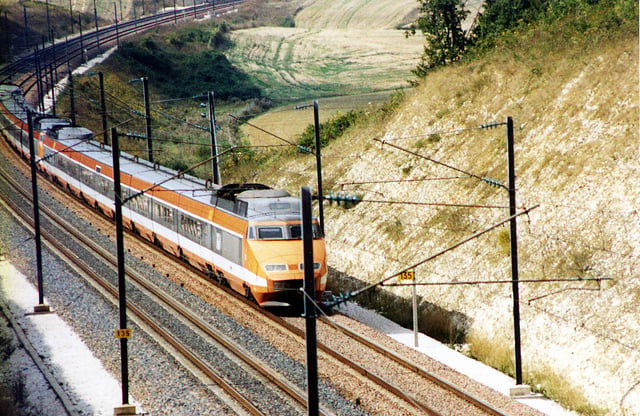
A TGV Sud-Est set in the original orange livery, since superseded by silver and blue
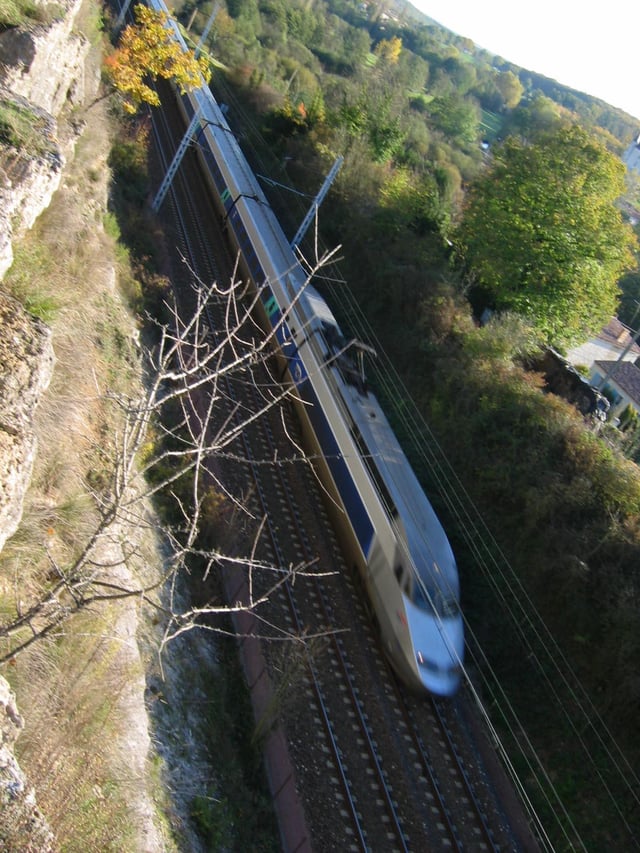
A TGV Réseau on an enhanced ordinary track

A TGV Réseau second-generation train at Marseille St-Charles
The Sud-Est fleet was built between 1978 and 1988 and operated the first TGV service, from Paris to Lyon in 1981. There are 107 passenger sets, of which nine are tri-current (including 15 kV, 16⅔ Hz AC for use in Switzerland) and the rest bi-current. There were seven bi-current half-sets without seats that carried mail for La Poste between Paris, Lyon and Provence, in a distinctive yellow livery until they were phased out in 2015.
Each set is made up of two power cars and eight carriages (capacity 345 seats), including a powered bogie in the carriages adjacent to the power cars. They are 200 m (660 ft) long and 2.81 m (9.2 ft) wide. They weigh 385 tonnes with a power output of 6,450 kW under 25 kV.
The sets were built to run at 270 km/h (170 mph) but most were upgraded to 300 km/h (190 mph) during mid-life refurbishment in preparation for the opening of the LGV Méditerranée. The few sets that still have a maximum speed of 270 km/h operate on those routes that include a comparatively short distance on LGV, such as to Switzerland via Dijon; SNCF did not consider it financially worthwhile to upgrade their speed for a marginal reduction in journey time.
TGV Atlantique
The 105-strong bi-current Atlantique fleet was built between 1988 and 1992 for the opening of the LGV Atlantique and entry into service began in 1989. They are 237.5 m (779 ft) long and 2.9 m (9.5 ft) wide. They weigh 444 tonnes, and are made up of two power cars and ten carriages with a capacity of 485 seats. They were built with a maximum speed of 300 km/h (190 mph) and 8,800 kW of power under 25 kV. The efficiency of the Atlantique with all seats filled has been calculated at 767 PMPG, though with a typical occupancy of 60% it is about 460 PMPG (a Toyota Prius with three passengers is 144 PMPG).[28]
Modified unit 325 set the world speed record in 1990 on the LGV before its opening. Modifications such as improved aerodynamics, larger wheels and improved braking were made to enable speeds of over 500 km/h (310 mph). The set was reduced to two power cars and three carriages to improve the power-to-weight ratio, weighing 250 tonnes. Three carriages, including the bar carriage in the centre, is the minimum possible configuration because of the articulation.
TGV Réseau
The first Réseau (Network) sets entered service in 1993. Fifty bi-current sets were ordered in 1990, supplemented by 40 tri-current sets in 1992/1993. Ten tri-current sets carry the Thalys livery and are known as Thalys PBA (Paris-Brussels-Amsterdam) sets. As well as using standard French voltages, the tri-current sets can operate under the Netherlands' 1.5 kV and Italian and Belgian 3 kV DC supplies.
They are formed of two power cars (8,800 kW under 25 kV – as TGV Atlantique) and eight carriages, giving a capacity of 377 seats. They have a top speed of 320 km/h. They are 200 m (660 ft) long and are 2.90 m (9.5 ft) wide. The bi-current sets weigh 383 tonnes: owing to axle-load restrictions in Belgium the tri-current sets have a series of modifications, such as the replacement of steel with aluminium and hollow axles, to reduce the weight to under 17 t per axle.
Owing to early complaints of uncomfortable pressure changes when entering tunnels at high speed on the LGV Atlantique, the Réseau sets are now pressure-sealed. They can be coupled to a Duplex set.
Eurostar
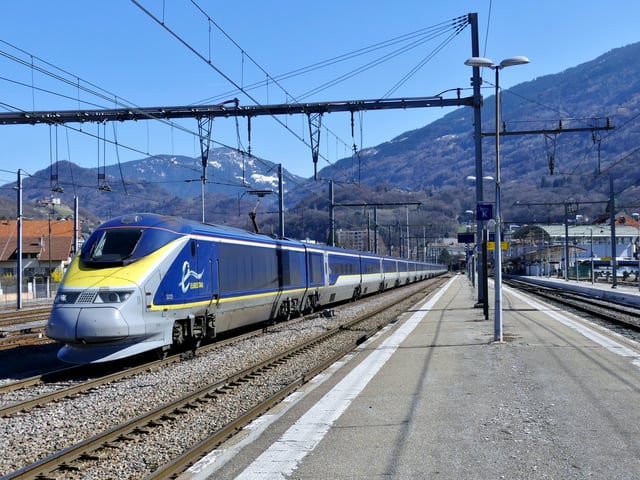
Eurostar at Gare d'Albertville. These long trains connect London with Paris and Brussels, are narrower to fit the British loading gauge (this was required when running services to and from London Waterloo), and have extensive fireproofing in case of fire in the Channel Tunnel.
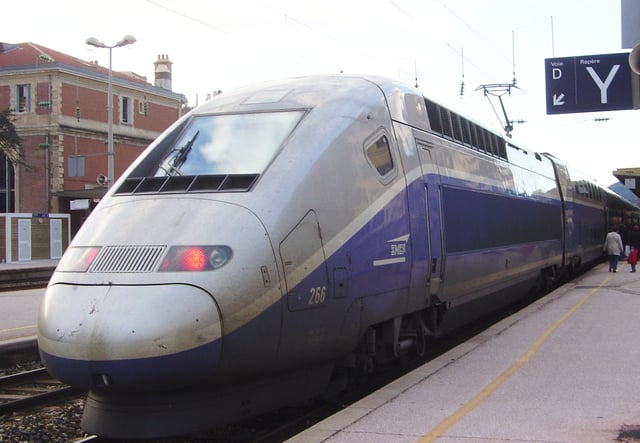
The TGV Duplex power cars use a more streamlined nose than previous TGVs
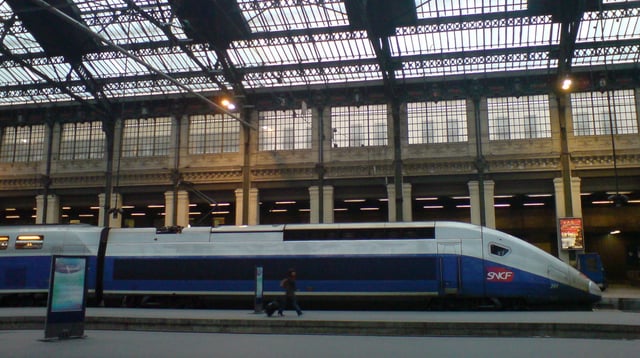
TGV Duplex power car in profile
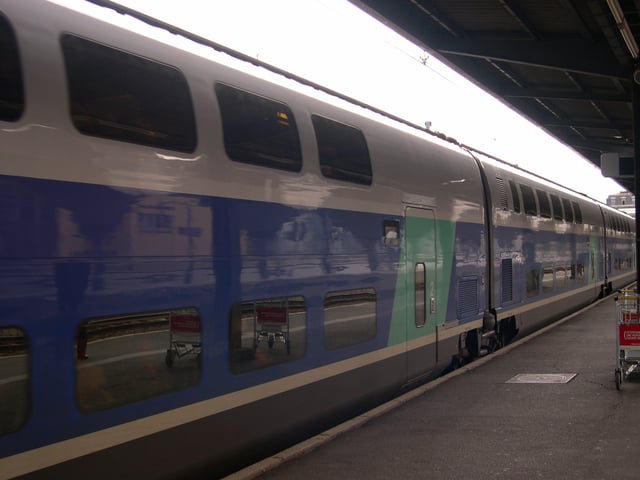
TGV Duplex trains have bi-level carriages
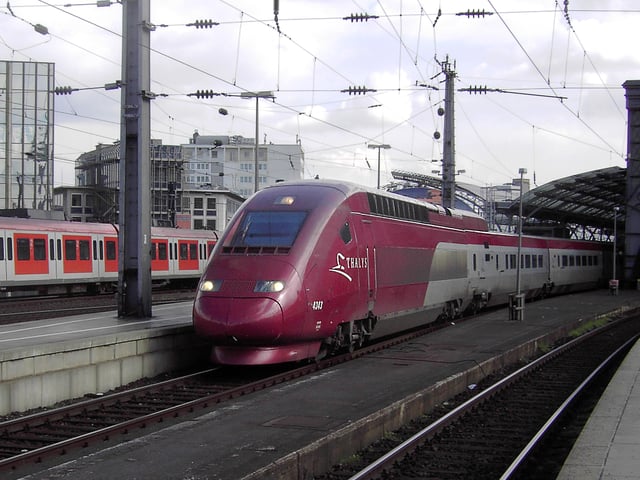
A Thalys PBKA at Köln Hauptbahnhof
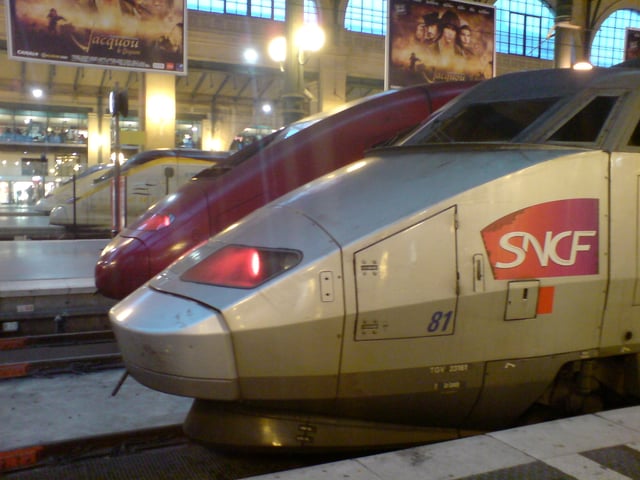
Eurostar, Thalys and TGV PSE No 81 at Paris Gare du Nord
The Eurostar train is essentially a long TGV,[29] modified for use in the United Kingdom and through the Channel Tunnel. Differences include a smaller cross-section to fit within the constrictive British loading gauge (though High Speed 1 can accommodate Berne gauge traffic, this feature was required when Eurostar trains operated on existing main line tracks from London Waterloo to the Channel Tunnel), British-designed asynchronous traction motors, and extensive fireproofing in case of fire in the Channel Tunnel. They also have yellow front panels, which are required for all trains operating on track owned by Network Rail or High Speed 1 in the UK.
In the UK they are classified as Class 373. In the planning stages they were called TransManche Super Train (Cross-channel Super Train). They were built by GEC-Alsthom (now Alstom) in La Rochelle (France), Belfort (France) and Washwood Heath (England), entering service in 1993.
Two types were built: Three Capitals sets, consisting of two power cars and 18 carriages, including two with one powered bogie each; and North of London sets, with 14 carriages. They consist of two identical half-sets that are not articulated in the middle, so that in case of emergency in the Channel Tunnel, one half of the train can be uncoupled and driven out of the tunnel. Each half-set is numbered separately.
Thirty-eight full sets, plus one spare power car, were ordered: 16 by SNCF, four by SNCB/NMBS, and 18 by British Rail, of which seven were North of London sets. Upon the privatisation of British Rail, the BR sets were bought by London & Continental Railways (LCR), whose subsidiary Eurostar (UK) Limited was managed by a consortium of National Express (40%), SNCF (35%), SNCB/NMBS (15%) and British Airways (10%) from 1998 to 2010. Following the merger of the separate Eurostar operators on 1 September 2010, ownership of all jointly owned sets transferred to the parent company, Eurostar International Limited.
The sets operate at a maximum speed of 300 km/h (186 mph), with the power cars supplying 12,240 kW of power. The Three Capitals sets are 394 m (1,293 ft) long and have 766 seats, weighing 752 tonnes. The North of London sets have 558 seats. All are at least tri-current and are able to operate on 25 kV, 50 Hz AC (on LGVs, including High Speed 1, and on UK overhead electrified lines), 3 kV DC on lignes classiques in Belgium and 750 V DC on the UK former Southern Region third rail network. The third rail equipment was removed in 2007 when the second section of High Speed 1 was opened between London and the Channel Tunnel, which uses 25 kV, 50 Hz AC. Five of the Three Capitals sets owned by SNCF are quadri-current and are able to operate on French lignes classiques at 1500 V DC.
Three of the Three Capitals sets owned by SNCF are in French domestic use and carry the silver and blue TGV livery. The North of London sets, intended to provide Regional Eurostar services from continental Europe to UK cities north of London using the West Coast and East Coast Main Lines, have never seen regular international use: budget airlines in the UK offered lower fares. A few of the sets were leased to GNER for use on some services from London King's Cross to York and Leeds, with two carrying its dark blue livery. The lease ended in December 2005 and a year later the same sets were working SNCF services to Calais in Eurostar livery, albeit with the Eurostar branding and yellow front panels removed.[30][31]
The chief executive of Eurostar, Richard Brown, suggested that the trains could be replaced by double-deck trains similar to the TGV Duplex when they are withdrawn. A double-deck fleet could carry 40 million passengers per year from Britain to Continental Europe, equivalent to adding an extra runway at a London airport.[32]
Eurostar has higher security measures than other TGV train services.[33] Luggage is screened and passengers are required to check in 30 minutes before departure. Because the UK is not part of the Schengen Area, and because France and Belgium are not part of the Common Travel Area, passengers are subject to immigration checks. These take place before passengers board the train, so officials from the UK Border Force are stationed in France and Belgium, with their French counterparts stationed in the UK.
In October 2010, Eurostar ordered 10 Class 374 "Eurostar e320" trains from Siemens to run on its existing routes from London to Paris and Brussels as well as a new route to Amsterdam alongside its Class 373 fleet. In 2016, Eurostar announced that it would keep 8 Class 373 sets in service once the full fleet of 374s (E320s) were in service with the rest of the Class 373 sets to be either stored or scrapped. The Class 373 sets that Eurostar would retain would be fully refurbished and repainted to match the livery of the new Class 374 E320 trains.[34]
TGV Duplex
The Duplex was built to increase TGV capacity without increasing train length or the number of trains. Each carriage has two levels, with access doors at the lower level taking advantage of low French platforms. A staircase gives access to the upper level, where the gangway between carriages is located. There are 512 seats per set. On busy routes such as Paris-Marseille they are operated in pairs, providing 1,024 seats in two Duplex sets or 800 in a Duplex set plus a Reseau set. Each set has a wheelchair accessible compartment.
After a lengthy development process starting in 1988 (during which they were known as the TGV-2N) the original batch of 30 was built between 1995 and 1998. Further deliveries started in 2000 with the Duplex fleet now totalling 160 units, making it the backbone of the SNCF TGV-fleet. They weigh 380 tonnes and are 200 m (660 ft) long, made up of two power cars and eight carriages. Extensive use of aluminium means that they weigh not much more than the TGV Réseau sets they supplement. The bi-current power cars provide 8,800 kW, and they have a slightly increased speed of 320 km/h (200 mph).
Duplex TGVs are now operating on all of the French high speed lines.[35]
Thalys PBKA
Unlike Thalys PBA sets, the PBKA (Paris-Brussels-Cologne-Amsterdam) sets were built exclusively for Thalys. They are technologically similar to TGV Duplex sets, but single deck. They are quadri-current, operating under 25 kV, 50 Hz AC (LGVs), 15 kV 16⅔ Hz AC (Germany, Switzerland), 3 kV DC (Belgium) and 1.5 kV DC (Dutch and French lignes classiques). Their top speed is 300 km/h (186 mph) under 25 kV, with two power cars supplying 8,800 kW. When operating under 15 kV power output drops to 3,680 kW, resulting in a very poor power-to-weight-ratio on German high-speed lines.[36] They have eight carriages and are 200 m (660 ft) long, weighing a total of 385 tonnes. They have 377 seats.
Seventeen trains were ordered: nine by SNCB/NMBS, six by SNCF and two by NS. Deutsche Bahn contributed to financing two of the SNCB/NMBS sets.
TGV POS
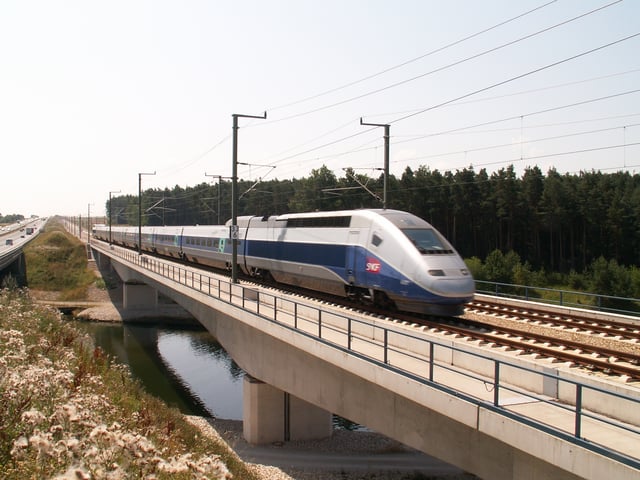
TGV POS have the newer power cars unlike a TGV Réseau
TGV POS (Paris-Ostfrankreich-Süddeutschland or Paris-Eastern France-Southern Germany) are used on the LGV Est.
They consist of two Duplex power cars with eight TGV Réseau-type carriages, with a power output of 9,600 kW and a top speed of 320 km/h (200 mph). Unlike TGV-A, TGV-R and TGV-D, they have asynchronous motors, and isolation of an individual motor is possible in case of failure.
Euroduplex (TGV 2N2)
The bi-current 2N2 (Euroduplex) can be regarded as the fourth generation of Duplex. The series was commissioned from December 2011 for links to Germany and Switzerland (tri-current trains) and to cope with the increased traffic due to the opening of the LGV Rhine-Rhone.
They are numbered from 800, and are limited to 320 km/h (200 mph). ERTMS makes them compatible to allow access to Spain in support Dasye.
TGV technology outside France
TGV technology has been adopted in a number of other countries:[37]
AVE (Alta Velocidad Española), in Spain.[38]
Thalys in Belgium, the Netherlands and Germany.
Korea Train Express (KTX), in South Korea.[39]
British Rail Class 373 operates Eurostar services between the United Kingdom, France, Belgium and the Netherlands.
Acela Express, a high-speed tilting train built by TGV participant Bombardier for the United States. The Acela uses several TGV technologies including the motors, electrical/drivetrain system (rectifiers, inverters, regenerative braking technology), truck structure and disc brakes, and crash energy management technology to control structural deformations in accidents.[40] However, the Acela's tilting, non-articulated carriages are derived from the Bombardier's Canadian LRC trains and are custom built for U.S. Federal Railroad Administration crash standards.[40]
The Moroccan government agreed to a €2 billion contract for Alstom to build Al-Boraq, an LGV between Tangier and Casablanca which opened in 2018.[41]
Italian open-access high-speed operator Nuovo Trasporto Viaggiatori has signed up with Alstom to purchase 25 AGV 11-car sets (TGV 4th generation, running at 350 km/h (220 mph)) for delivery starting in 2009.[42]
Future TGVs
SNCF and Alstom are investigating new technology that could be used for high-speed transport. The development of TGV trains is being pursued in the form of the Automotrice à grande vitesse (AGV) high-speed multiple unit with motors under each carriage.[43] Investigations are being carried out with the aim of producing trains at the same cost as TGVs with the same safety standards. AGVs of the same length as TGVs could have up to 450 seats. The target speed is 360 kilometres per hour (220 mph). The prototype AGV was unveiled by Alstom on 5 February 2008.[44]
Italian operator NTV is the first customer for the AGV, and became the first open-access high-speed rail operator in Europe, starting operation in 2011.[42]
The design process of the next generation of TGVs began in 2016 when SNCF and Alstom signed an agreement to jointly develop the trainsets, with goals of reducing purchase and operating costs, as well as improved interior design.[45] The design that emerged from the process was named Avelia Horizon, and in July 2018 SNCF ordered 100 trainsets with deliveries expected to begin in 2023.[46]
Accidents
In almost three decades of high-speed operation, the TGV has not recorded a single passenger fatality due to accidents while running at high speed on normal passenger service. There have been several accidents, including three derailments at or above 270 km/h (170 mph), but in only one of these—a test run on a new line—did carriages overturn. This is credited in part to the stiffness that the articulated design lends to the train. There have been fatal accidents involving TGVs on lignes classiques, where the trains are exposed to the same dangers as normal trains, such as level crossings. These include one terrorist bombing, which could as well have occurred at high speed as not.
On LGVs
14 December 1992: TGV 920 from Annecy to Paris, operated by set 56, derailed at 270 km/h (170 mph) at Mâcon-Loché TGV station (Saône-et-Loire). A previous emergency stop had caused a wheel flat; the bogie concerned derailed while crossing the points at the entrance to the station. No one on the train was injured, but 25 passengers waiting on the platform for another TGV were slightly injured by ballast that was thrown up from the trackbed.
21 December 1993: TGV 7150 from Valenciennes to Paris, operated by set 511, derailed at 300 km/h (190 mph) at the site of Haute Picardie TGV station, before it was built. Rain had caused a hole to open up under the track; the hole dated from the First World War but had not been detected during construction. The front power car and four carriages derailed but remained aligned with the track. Of the 200 passengers, one was slightly injured.
5 June 2000: Eurostar 9073 from Paris to London, operated by sets 3101/2 owned by SNCB/NMBS, derailed at 250 km/h (155 mph) in the Nord-Pas de Calais region near Croisilles.[47] The transmission assembly on the rear bogie of the front power car failed, with parts falling onto the track. Four bogies out of 24 derailed. Out of 501 passengers, seven were bruised[48] and others treated for shock.[49]
14 November 2015: TGV 2369 was involved in the Eckwersheim derailment, near Strasbourg, while being tested on the then-unopened second phase of the LGV Est. The derailment resulted in 11 deaths among those aboard, while the 11 others aboard the train were seriously injured.[50] Excessive speed has been cited as the cause.[51]
On lignes classiques
31 December 1983: A bomb allegedly planted by the terrorist organisation of Carlos the Jackal exploded on board a TGV from Marseille to Paris; two people were killed.
28 September 1988: TGV 736, operated by set 70 "Melun", collided with a lorry carrying an electric transformer weighing 100 tonnes that had become stuck on a level crossing in Voiron, Isère. The vehicle had not obtained the required crossing permit from the French Direction départementale de l'équipement. The weight of the lorry caused a very violent collision; the train driver and a passenger died, and 25 passengers were slightly injured.
4 January 1991: after a brake failure, TGV 360 ran away from Châtillon depot. The train was directed onto an unoccupied track and collided with the car loading ramp at Paris-Vaugirard station at 60 km/h (37 mph). No one was injured. The leading power car and the first two carriages were severely damaged, and were rebuilt.
25 September 1997: TGV 7119 from Paris to Dunkerque, operated by set 502, collided at 130 km/h (81 mph) with a 70 tonne asphalt paving machine on a level crossing at Bierne, near Dunkerque. The power car spun round and fell down an embankment. The front two carriages left the track and came to a stop in woods beside the track. Seven people were injured.
31 October 2001: TGV 8515 from Paris to Irun derailed at 130 km/h (81 mph) near Dax in southwest France. All ten carriages derailed and the rear power unit fell over. The cause was a broken rail.
30 January 2003: a TGV from Dunkerque to Paris collided at 106 km/h (66 mph) with a heavy goods vehicle stuck on the level crossing at Esquelbecq in northern France. The front power car was severely damaged, but only one bogie derailed. Only the driver was slightly injured.
19 December 2007: a TGV from Paris to Geneva collided at about 100 km/h (62 mph) with a truck on a level crossing near Tossiat in eastern France, near the Swiss border. The driver of the truck died; on the train, one person was seriously injured and 24 were slightly injured.[52]
17 July 2014: a TER train ran into the rear of a TGV at Denguin, Pyrénées-Atlantiques. Forty people were injured.
Following the number of accidents at level crossings, an effort has been made to remove all level crossings on lignes classiques used by TGVs. The ligne classique from Tours to Bordeaux at the end of the LGV Atlantique has no level crossings as a result.
Protests against the TGV
The first environmental protests against the building of an LGV occurred in May 1990 during the planning stages of the LGV Méditerranée. Protesters blocked a railway viaduct to protest against the planned route, arguing that it was unnecessary, and that trains could keep using existing lines to reach Marseille from Lyon.[53]
Lyon Turin Ferroviaire (Lyon-Chambéry-Turin), which would connect the TGV network to the Italian TAV network, has been the subject of demonstrations in Italy. While most Italian political parties agree on the construction of this line, some inhabitants of the towns where construction would take place oppose it vehemently. The concerns put forward by the protesters centre on storage of dangerous materials mined during tunnel boring, like asbestos and perhaps uranium, in the open air.. This health danger could be avoided by using more expensive techniques for handling radioactive materials. A six-month delay in the start of construction has been decided in order to study solutions. In addition to the concerns of the residents, RFB – a ten-year-old national movement – opposes the development of Italy's TAV high-speed rail network as a whole.[54]
General complaints about the noise of TGVs passing near towns and villages have led the SNCF to build acoustic fencing along large sections of LGV to reduce the disturbance to residents, but protests still take place where SNCF has not addressed the issue.[55]
Special services
In addition to its standard services, TGV also provides mail and "low cost" travel services
For many years, a service termed SNCF TGV La Poste has been transporting mail for the French mail service, La Poste. It used windowless but otherwise standard TGV rolling stock, painted in the yellow and blue livery of La Poste.
In 2013 a new "low cost" TGV service was created by the SNCF. It was called Ouigo and was designed to mimic and challenge low cost airline services.
Rebranding
See also
iDTGV
High-speed rail in France
TER-GV – TGVs operating on relatively short distances along the LGV Nord
TGV track construction
TGV world speed record – overview and chronology of speed record attempts
Train categories in Europe
V150 (train)